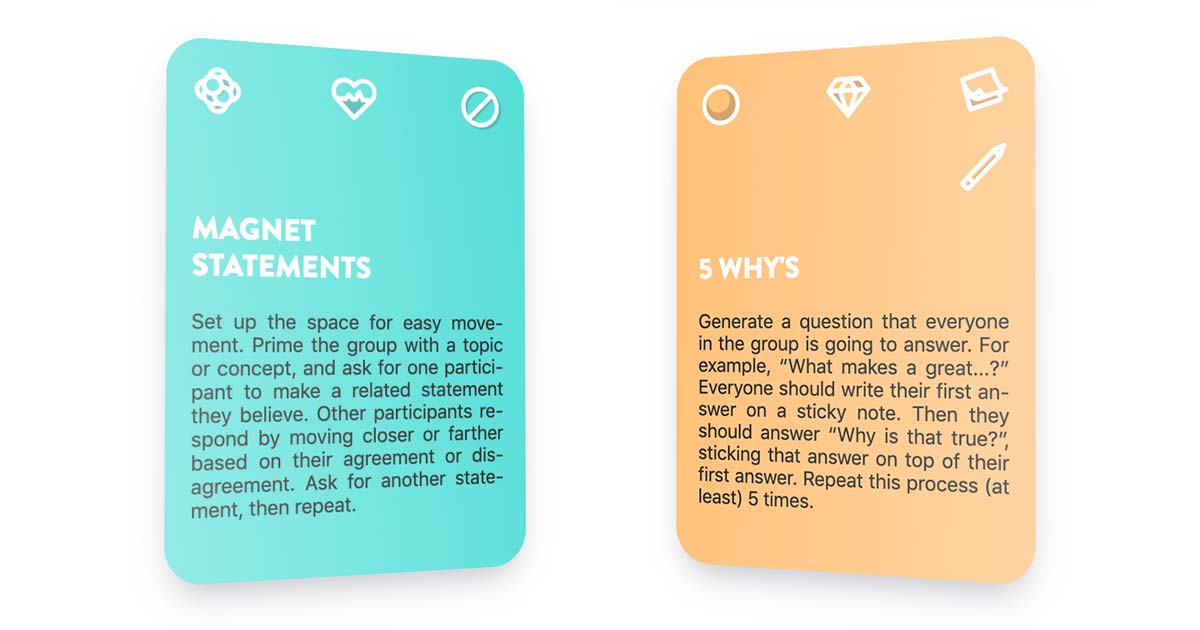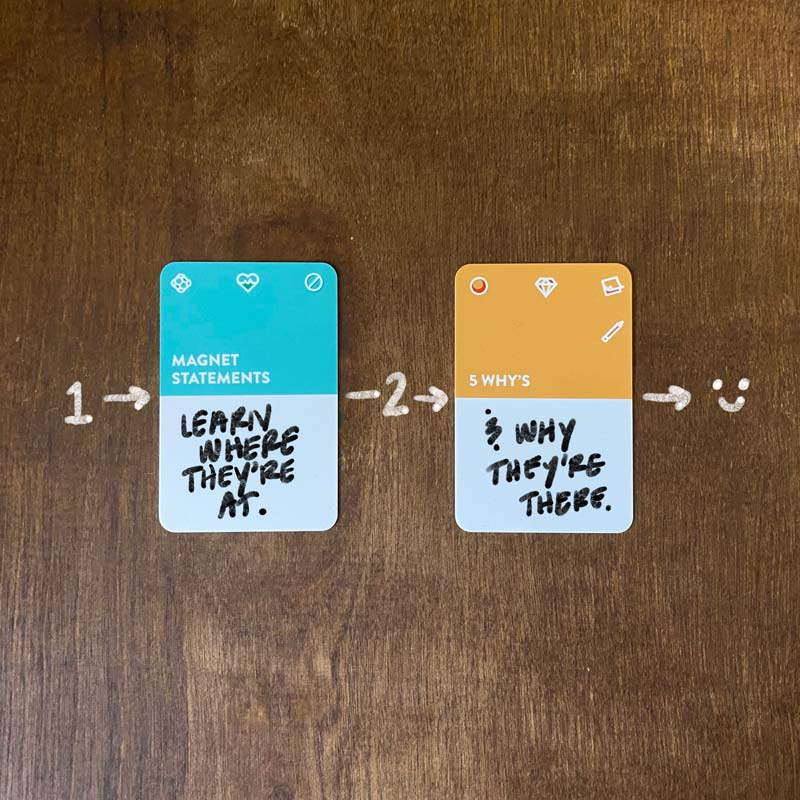Have you ever been asked to facilitate a gig where the client says the group needs this one thing, but you suspect it’s something else entirely, leaving you to figure out what is really needed as soon as you get in front of the group?
How about a situation where you need to create an opportunity for the group to listen and understand each other?
Or perhaps you’ve needed to create a scenario where participants are challenged to investigate their initial reactions to each other?
What if I told you that a sequence of two activities – the same two activities! – is all you need to address these common facilitation scenarios?
Hopefully you’d respond, “Intriguing!” and continue to read this article.
Today, I want to introduce you to a sequence of two facilitator cards that you can use to address these examples and many others: Magnet Statements + 5 Whys. If you’re not familiar with them, this would be a good time to click on the links below and read about the activities before going on!
Magnet Statements involves movement, full-group interaction, no props, and participants reacting to many different statements.
5 Whys is different in almost every way. It is individually reflective, writing-based, and involves simple props, no movement, and deep thinking.

With playing cards, a sequence might refer to a run of cards, the ace through five of hearts. With Facilitator Cards a sequence is any two-or-more [cards] (https://www.facilitator.cards/cards/) in a specific order to create an element of your facilitation. While each activity is a powerful tool on its own, the sequence of the cards creates a new powerful tool that can be greater than the sum of its parts.
Why the Magnet Statement + 5 Whys Sequence Works
What’s beautiful about this sequence is that for both these cards, the facilitator provides the framing or initial question, but the vast majority of the content comes from the group. Starting with Magnet Statements allows a lot of content to be surfaced quickly and allows you to assess how to use that content. Then pairing it with 5 Whys allows you to put your assessment of the content immediately to further use and for the group to dig in deeper. They play off and amplify each other’s strengths.
Also, as a useful bonus, these activities are different in almost every way: group size, style of thinking participants are asked to do, use of props or not, and energy level of the participants. This ensures that there is no feeling of redundancy and allows for different types of participation from the group.
How to Facilitate this Sequence
To facilitate this sequence, start by running Magnet Statements in the standard way, picking the theme for your group to make statements around and then inviting participants to make and react to each other’s statements.
While the group is moving through the Magnet Statements, take note of which statements are activating the group. Keep an eye out for
- expressive body language after the statement is made (think scoffs, rolling eyes, participants saying things to themselves);
- the way that participants relate to people around them (they talk with people they are near while they are moving around, or they talk with people who end up near them while looking at or gesturing to the people they are distant from)
- statements where the spread of participants is really different from how they have been grouping (i.e. if the group is suddenly really spread out when they have largely been close together and vice versa);
- statements where the group looks surprised to see one another’s reactions.
As Magnet Statements comes to a close and participants transition to sitting in their seats, pass out supplies for 5 Whys. As participants are getting their supplies, decide on a single statement you noted from Magnet Statements to hone in on, one that activated the group in a way that you believe is worth investigating further. Change this statement into a question for the group to investigate in 5 Whys.
Write up this initial question you’ve just formed on a flipchart or whiteboard. Then run 5 Whys as you normally would, using that question as the initial starting point.
When to Use this Sequence
While there are numerous times you might put this sequence to use, I’ll expand on the three examples mentioned in the intro and how you might use this sequence to benefit your facilitation in those scenarios.
When Facilitating a New Group with Unconfirmed Challenge/Conflict
As facilitators, we know that when we’re working with a new group of folks, often the challenge they tell us is not what’s really going on. This sequence is perfect when either (1) we don’t know what their challenge/conflict is and they don’t either OR (2) when we don’t know what their challenge/conflict is and we suspect their diagnosis may be off. This sequence allows us to check in on multiple possibilities (without having to lead with any one of them) and then to hone in on the one we think is worth digging into.
When facilitating Magnet Statements, pay special attention to anywhere the group gets emotionally activated by a statement: shifts in body language, talking amongst each other, or expressions of frustration. If there are multiple statements, consider which the group was most spread out on. For 5 Whys, use the statement you feel will best serve to get to the bottom of what the group needs to address.
When the Group Needs to Better Understand Each Other
Often times, the group is under the false assumption that everyone agrees with what they think, and it’s our job as facilitators to help them realize that isn’t true. If your participants are saying things like, “Obviously,” or “I’m sure we all agree,” but you can tell that isn’t necessarily true or needs to be unpacked further, here are some tips.
When inviting participants to make statements that are true for them, encourage a broad range of participation, especially participants who have been quieter to speak up. If people start questioning each other (“Why would you say that?”), remind them that in this activity, we only respond by movement and will talk about it after the activity is over. When participants are making statements, note what statements participants want to ask questions or gain more clarity about. Additionally, look for statements where participants are only talking to the people who are near them and you can sense a bit of “us vs. them” energy in the room. Use one of these statements you’ve flagged as a jumping-off point for 5 Whys.
To Challenge Participants to Investigate their Motivations
Sometimes participants don’t feel they can connect to people they don’t see eye-to-eye with, and alternatively that they will definitely feel connected to those who agree with them on an issue. Yet we know as facilitators that when participants are invited to look beyond their initial reactions and connect to each other’s deep beliefs or motivations, things can look a lot different. We can help our participants go to that deeper place using this same sequence.
What statements lead your participants to expressing judgement (often through body language or quick conversation with those near to them) towards people who disagree with them? This might also be communicated through connecting with the people who agree with them. Additionally, keep an eye out for statements that use catchphrases or buzzwords, as these are often statements that have polarized opinions that rarely get unpacked. Consider using any of these statements as your jumping-off point.
How Will You Use this Sequence?
As facilitators, we have big challenges on our hands. Many of us have spent countless hours connecting with our contacts, learning about the group, trying to figure out what the problem is that we need to address. Many of us have watched participants make sweeping generalizations for the entire group and crumble the connections within the room. We’ve seen participants create “us vs. them” dynamics with the most surface level reactions to go off of. And while there are numerous ways we can work through any of these challenges, today I offer you one way (with two activities) to address these situations and many others we may encounter as facilitators.
Where will you take this sequence? How do you see yourself using it with your groups? Give it a go and then [let us know] (mailto: hello@facilitator.cards).
Find both these processing tools and more in the [Facilitator Cards Preview Pack] (https://www.facilitator.cards/preview-pack/)
